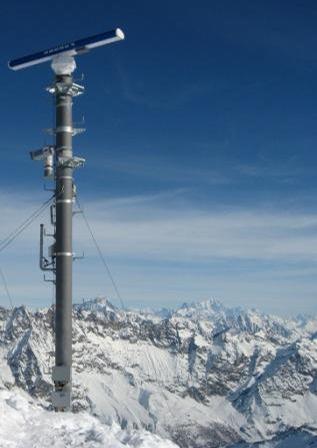Klein Matterhorn X-band Radar
Dates: 2007-2011
Funding: Canton Valais, ETH Zurich
PhD Student: Maurizio Savina
Principal Investigator: Prof. Paolo Burlando
Project Webpage: www.kmradar.ethz.ch
Abstract

Alpine hydrology is driven by orography to the extent that orography affects the space-time structure of precipitation. Mountain precipitation results from a multitude of processes such as mechanical lifting, enhancement, shadowing, feeder-seeder effect. Many of these processes are poorly understood, especially at small spatial and temporal scales. Consequently, this limits our understanding of the majority of the precipitation-related natural hazards occurring in both high- and lowlands.
This lack of knowledge is mainly due to the intrinsic limitations of our best measurement techniques: raingauges and weather radars. Raingauges collect only point observations, weather radars produce instantaneous 2-3D distributed reflectivity maps. The mountain cause a number of limitations of weather radar systems, which often are reliable in a limited space-time domain. A solution to this limitation might be the use of a number of cost-effective short-range X-band radars as complement to raingauges and conventional, large and expensive weather radars.
The KM project was a pilot experiment, which aimed to develop and assess a cost-effective X-band weather radar (LAWR) deployed in an Alpine setting. The LAWR was deployed between August 2007 and October 2011 on the summit of the Kl. Matterhorn, located in the Swiss-Italian Alps at 3883 m a.s.l. (Valais, Switzerland). This was the highest fix weather radar of the world. It guaranteed good radar visibility above the local Alpine area.
The radar site has a characteristic Alpine climate with related difficulties in the operating conditions. Indeed, much effort went into the improvement of hardware that in its final form was characterized by a mean time between failure of about two months, a great achievement for such environmental conditions. The fact that the state-of-the-art LAWR correction and conversion procedures were not reliable for Alpine applications, a new set of corrections and an Alpine radar conversion method were developed and tested. The results showed that cost-effective X-band weather radars can be deployed successfully also in the Alps. The modified LAWR was able to measure precipitation in all its forms as well as its spatial variability. A raingauge-based validation revealed uncertainty which, on the other hand, could be reduced by further hardware and software modifications.
The results of the KM project are highly useful guidelines to be adopted for installation of cost-effective X-band radar in Alpine and other settings.
Key Publications
- Burlando P. and M. Savina (2010), Der X-band Local Area Weather Radar (LAWR) auf dem Kleinen Matterhorn. Report for the Cantonal authorities. Link to the pdf.
- Savina, M., (2011), The use of a Cost-Effective X-band Weather Radar in Alpine Region. ETH Zurich Dissertation N0. 20141. Link to the pdf.
- Savina, M. and P. Burlando, (2010). The highest X-band radar in Europe: first achievements. Proceeding for the 6th European conference on radar in meteorology and hydrology - ERAD 2010 (ISBN 978-973-0-09057-4). external page See the pdf.
- Savina, M., P. Molnar, and P. Burlando (2011), Seasonal long-term persistence in radar precipitation in complex terrain, Water Resour. Res., 47, W10506, doi:10.1029/2010WR010170. external page Link to the paper.
- Savina, M., Schaeppi, B., Molnar, P., Burlando, P. and B. Sevruk, (2009). Comparison of recording precipitation gauges: tipping-bucket ANETZ and electronic weighing system MPS. Proceeding for the 8th International Workshop on Precipitation in Urban Areas, 2009, St. Moritz. Link to UrbanRain 09.
- Savina, M., Schaeppi, B., Molnar, P., Burlando, P. and B. Sevruk, (2011). Comparison of recording precipitation gauges: tipping-bucket ANETZ and electronic weighing system MPS. Atmospheric Research,doi: 10.1016/j.atmosres.2011.06.010. external page Link to the paper.